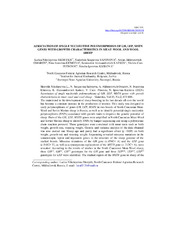Приказ основних података о документу
ASSOCIATION OF SINGLE NUCLEOTIDE POLYMORPHISMS OF GH, LEP, MSTN GENES WITH GROWTH CHARACTERISTICS IN MEAT-WOOL AND WOOL SHEEP
| dc.creator | Skorykh, Larisa Nikolayevna | |
| dc.creator | Safonova, Nadezhda Sergeevna | |
| dc.creator | Omarov, Arslan Akhmetovich | |
| dc.creator | Efimova, Nina Ivanovna | |
| dc.creator | Katkov, Konstantin Alexsandrovich | |
| dc.creator | Caro Petrovic, Violeta | |
| dc.creator | Kizilova, Natalia Igorevna | |
| dc.date.accessioned | 2023-11-16T12:43:52Z | |
| dc.date.available | 2023-11-16T12:43:52Z | |
| dc.date.issued | 2023 | |
| dc.identifier.issn | 0534-0012 | |
| dc.identifier.uri | http://r.istocar.bg.ac.rs/handle/123456789/957 | |
| dc.description.abstract | The main trend in the development of sheep breeding in the last decade all over the world has become a constant increase in the production of mutton. This study was designed to study polymorphisms of genes GH, LEP, MSTN in two breeds of North Caucasian Meat Wool and Soviet Merino sheep in Russia, as well as to identify potential single nucleotide polymorphisms (SNPs) associated with growth traits to improve the genetic potential of sheep. Parts of the GH, LEP, MSTN genes were amplified in North Caucasian Meat-Wool and Soviet Merino sheep to identify SNPs by Sanger sequencing and using a polymerase chain reaction protocol. These genotypes were correlated with meat traits such as birth weight, growth rate, weaning weight. . Genetic and variance analysis of the data obtained was also carried out. Sheep age and parity had a significant effect (p<0.05) on birth weight, growth rate and weaning weight. Sequencing revealed missense mutations in the somatotropin, leptin and myostatin genes in the structure of the sheep genome of the studied breeds. Missense mutations of the GH gene (c.476G> A) and the LEP gene (c.541G> T), as well as a synonymous replacement of the MSTN gene (c. 212C> A), were revealed. According to the results of studies in the North Caucasian Meat-Wool sheep, three GHCC, GHCT , GHTT genotypes for the GH gene and three LEPGG, LEPGT , LEPТТ genotypes for LEP were identified. The studied region of the MSTN gene in sheep of the North Caucasian meat and wool breed turned out to be monomorphic. According to the results of studies in Soviet Merino sheep, three genotypes GHCC, GHCT , GHTT for the GH gene, three genotypes MSTNСС , MSTNСА , MSTNАА for the MSTN gene, two genotypes LEPGG, LEPGT for the LEP gene were established. The analysis of associations showed a significant effect (p<0.05) of the GHСТ and LEPGT genotypes on the signs of sheep growth. Interestingly, the presence of the T-allele in sheep of the North Caucasian Meat-Wool breed tended to increase in weight during weaning (+2.2 kg) both for the GH gene and for the LEP gene (+ 1.6 kg). Interestingly, similar results were observed in sheep of the Soviet Merino breed, where the missense mutation led to an increase in weaning weight (+ 1.2 kg) for the GH gene and for the LEP gene (+1.3 kg). A synonymous MSTN gene substitution does not lead to a substitution of the coding amino acid, but may further lead to gene expression. The GH, LEP, and MSTN genes are proposed markers for improving growth traits in meat-wool and wool sheep, which will increase the ability to understand the genetic architecture of the genes underlying SNPs that influence such traits. | sr |
| dc.language.iso | en | sr |
| dc.publisher | Serbian Genetic Society | sr |
| dc.rights | openAccess | sr |
| dc.rights.uri | https://creativecommons.org/licenses/by/4.0/ | |
| dc.source | Genetika Časopis | sr |
| dc.subject | growth hormone gene (GH); | sr |
| dc.subject | leptin gene (LEP); | sr |
| dc.subject | myostatin gene (MSTN); | sr |
| dc.subject | sheep | sr |
| dc.title | ASSOCIATION OF SINGLE NUCLEOTIDE POLYMORPHISMS OF GH, LEP, MSTN GENES WITH GROWTH CHARACTERISTICS IN MEAT-WOOL AND WOOL SHEEP | sr |
| dc.type | article | sr |
| dc.rights.license | BY | sr |
| dc.citation.volume | 55 | |
| dc.citation.issue | 2 | |
| dc.citation.spage | 673 | |
| dc.citation.epage | 688 | |
| dc.identifier.doi | https://doi.org/10.2298/GENSR2302673S | |
| dc.identifier.fulltext | http://r.istocar.bg.ac.rs/bitstream/id/4523/bitstream_4523.pdf | |
| dc.type.version | publishedVersion | sr |


